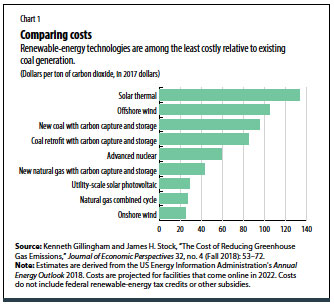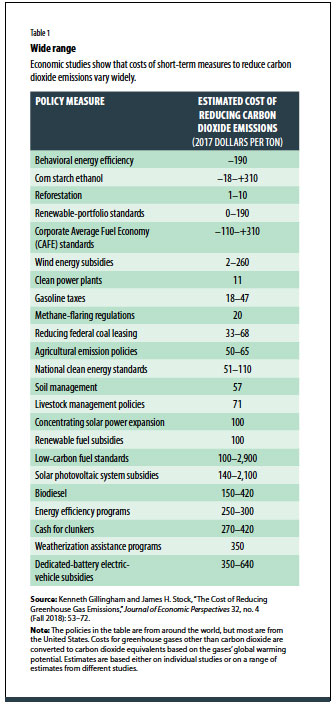For deep greenhouse gas emission reductions, a long-term perspective on costs is essential
The scientific consensus is clear: climate change is associated with increasingly frequent and intense natural disasters ranging from droughts and wildfires to hurricanes and coastal flooding. While the extent of the economic damage cannot be known for certain, strong evidence suggests it could be quite severe. The challenge for policymakers will be to decide how much to spend on measures to reduce greenhouse gas emissions. To do that, they must be able to compare the costs of various options, including renewable-energy sources and electric cars.
The challenge is taking on increasing urgency in the policy world as climate scientists argue that emission reductions must be rapid and deep, with a goal of reaching net zero by 2050, if not sooner (Millar and others 2017). That goal, which many countries have already embraced, will require a vast transformation of the energy sources used to power the global economy, and it would mean going far beyond business-as-usual technological progress. Indeed, the US Energy Information Administration’s International Energy Outlook 2019 projects that fossil fuels will still generate 57 percent of electricity in 2050.
How much would it cost to move beyond business as usual and come within striking distance of net-zero emissions by 2050? To answer this question, it’s important to distinguish between short- and long-term costs. In the short term, there are some inexpensive ways to reduce emissions, but deeper cuts run up against quickly rising costs. However, some activities—especially those involving fledgling low-carbon technologies—that appear expensive in the short term may actually turn out to be low-cost approaches in the long term, because of induced innovation. This insight suggests that the longer-term cost of mitigation may be lower than is widely assumed.
Short-term costs of technologies
To calculate the short-term costs of mitigating greenhouse gas emissions, economists estimate the up-front costs and divide by the number of tons of carbon dioxide (or equivalent) emissions reduced. For example, suppose a government spends $20 million to promote the development of wind farms to generate electricity, reducing carbon dioxide emissions by 1 million tons. The short-term cost of the mitigation would be $20 per ton. This method provides a useful way of comparing the costs of various ways of reducing emissions.
Of course, one must be cautious in interpreting results focused on an individual technology or policy in isolation. For instance, there could be interactions among policies, and the costs associated with technologies may vary by location and exactly how the technology is implemented. And estimates of such costs are changing every year. Indeed, the cost of solar and wind generation has declined rapidly over the past decade, and the decline appears likely to continue.

My colleague James Stock and I estimated the unsubsidized costs of various technologies to reduce greenhouse gas emissions based on a review of recent economic literature and the Energy Information Administration’s Annual Energy Outlook 2018 (Chart 1). The costs are expressed in relation to existing coal generation, which is a useful benchmark because coal is the most carbon-intensive fuel. In many countries, policymakers will have to decide whether to close existing coal plants on the path toward decarbonization. These estimates are averages from the United States, and one should be cautious in applying them elsewhere.
The most striking takeaway is that renewable-energy technologies are among the least costly. (This result can be applied outside the United States, because markets for most renewable technologies are global.) In fact, the cost of wind and solar may be even lower when implicit or explicit subsidies are included. However, these estimates do not account for the intermittency of renewable energy generation—after all, the sun does not shine and wind does not blow all the time (Joskow 2019). At high levels of use, renewables must be complemented with storage technologies such as pumped hydroelectric storage or batteries, or with a form of generation that can quickly fill the gap when the supply of wind or solar power falters.
In the United States, a low-cost, low-carbon alternative to coal is a power plant that incorporates both gas and steam turbines to increase efficiency. Known as natural gas combined-cycle generation, this solution takes advantage of the copious supply of inexpensive fracked shale gas. One caveat: the estimated cost of $27 per ton assumes that no methane leaks from wells, pipelines, or storage facilities. Methane is a potent greenhouse gas, and the gigantic leak at Aliso Canyon, California, in 2015 shows that natural-gas generation may produce higher greenhouse gas emissions—and thus higher costs per ton of all greenhouse gases reduced.
Social cost
To understand how sensible it is to spend money on these emissions reductions, we can compare them to estimates of carbon’s social cost, which quantifies the incremental damage resulting from emitting a ton of carbon dioxide and other greenhouse gases into the atmosphere. This incremental damage includes factors such as losses (or gains in northern climates) to agriculture caused by global warming, flooding from sea level rise, and destruction from more-severe tropical cyclones and additional wildfires. The administration of US President Barack Obama developed a central-case estimate of $50 per ton of carbon dioxide in 2019.
Several technologies for mitigation turn out to be less expensive than carbon when this estimate of carbon’s social cost is used (suggesting they are no-brainers), while others are more expensive, such as solar thermal and offshore wind. Benchmarks other than the $50 per ton estimate may also be useful. For instance, a recent IMF report estimates that a tax of $75 per ton of carbon dioxide applied around the world would make it possible to meet the Paris Agreement target of limiting global warming to 2˚C over preindustrial levels. If this $75 estimate is used instead of $50, advanced nuclear becomes another option that is less expensive than carbon’s social cost.
Short-term costs of policies
So far, we have looked at the costs today of unsubsidized technologies, which is useful for understanding the direction markets will be going in the near future. It is clear that as old generation plants are retired and new ones are built, there will be a shift toward renewable-energy technologies, regardless of policy. However, this switch may be much slower than would otherwise be dictated by the ambitious goals many governments have set. So it is also important to understand the costs of emission reductions resulting from different policy measures governments could undertake.

A look at studies in the economics literature reveals an extremely wide range of costs for policies that have been implemented and evaluated (Table 1). At the low end are energy efficiency interventions, which actually save money. In behavioral economics, these are often referred to as “nudges,” because they simply involve providing or reframing information to influence, or nudge, energy-consumption-related decisions toward a more environmentally friendly approach. A well-known example are reports included in electricity bills that compare a household’s electricity use with that of its neighbors. Such interventions are inexpensive and can reduce electricity use by about 2 percent, yielding net savings. While these measures may pay for themselves, the resulting emission reductions tend to be modest and have a relatively small role in deeper decarbonization efforts.
At the high-cost end are many policies that appear to be quite expensive when looking at short-run, static costs. Most notable are policies to induce additional renewable generation and to help decarbonize transportation. In fact, the most expensive are subsidies for electric vehicles. This is because in many places, such vehicles are charged using electricity from fossil fuel sources, which reduces potential emission savings.
Yet such technologies may ultimately be cheaper than the table’s short-term estimates suggest. That’s because many may provide side benefits such as reduced air pollution, which could make them attractive even if they entail high carbon emission-reduction costs. Moreover, in the longer term, their resulting emission reductions and cost per ton reduced may look very different, owing to spillovers from induced technological change.
Long-term, dynamic costs
Why do innovation spillovers make a difference? Climate change is a long-term, intergenerational problem, with carbon dioxide in the atmosphere persisting for hundreds to thousands of years. Thus, technological change and innovation are central to longer-term efforts to mitigate climate change by developing alternatives to fossil fuels. While technologies to steeply reduce emissions are available today, there is not only tremendous inertia in the energy system, but also much room for further cost declines in the technology. These considerations lend themselves to a long-term, dynamic perspective that accounts for how spending on new technologies today may lower the cost of reducing emissions in the future.
There are several reasons why taking the longer-run, dynamic perspective makes sense. Economists know that research and development generates spillovers because firms often can only partly appropriate the gains it brings. For example, once a patent expires, any firm can take advantage of the associated innovation. There may also be cases where engineering and managerial improvements from producing a new technology lower the technology’s costs (often called “learning by doing”), and some of the cost reductions may spill over to other firms. For instance, there is evidence that firms in the semiconductor industry lowered their production costs as they produced more of each generation of semiconductors and that these lowered costs spilled over to other firms (Irwin and Klenow 1994). There may also be positive network effects, with benefits to society from the adoption of a single standard, such as one plug that works for charging all electric vehicles. All three types of spillovers allow other firms to reduce costs, improving social welfare and providing an economic motivation for carefully designed policies to foster such spillovers.
Apart from spillovers, recent work in the economics of clean-energy innovation has emphasized that optimal policy may be quite different in the long term simply because expenditures today may have long-term effects. Some of the approaches to reducing emissions that are more expensive in the short term may spur innovation that could lead to lower long-term costs than existing approaches. Consider subsidies for electric vehicles, which include rapidly improving technology such as batteries. If policy today for clean technology can reduce costs substantially in the future, then it may make sense to undertake more expensive options today (Acemoglu and others 2016; Vogt-Schilb and others 2018). In principle, this finding holds even if only a single firm adopts the low-carbon innovation (so there would be no innovation spillovers), although in practice there will almost certainly be spillovers leading to lower long-term costs. The key insight is that when society chooses how best to address climate change, the optimal long-term decision may differ from the short-term, myopic decision. Of course, it is not easy to foresee how technology will unfold, so any decision involves uncertainty. But we know that mature technologies are less likely to see major leaps than nascent ones. Thus, the long-term view applies only to newer low-carbon technologies with real potential to reduce costs in the future.
Game changers
Let’s return to our original question. Is it possible to decarbonize deeply enough to come within striking distance of net-zero greenhouse gas emissions by 2050? Yes, it is feasible even today—the technologies exist. Yet such a vast transformation of the energy system will be costly and challenging if attempted all at once, especially considering the large short-term costs of the transition for fossil-fuel-reliant developing nations. There are certainly inexpensive measures that can be implemented today, including energy conservation, efficiency nudges, and the replacement of retiring fossil-fuel powered electricity generation with renewables. The costs of these measures are already lower than the damage from climate change they would avert, based on estimates of carbon’s social cost. But many other approaches are quite costly in the short term, especially efforts to promote new low-carbon technologies. However, when the policies have strong potential to spur innovation, they may lead to much lower total costs over the longer term.
A long-term perspective that keeps innovation in mind is crucial in considering ways to tackle climate change. Innovations such as small modular nuclear reactors and carbon capture technologies could be game changers in achieving net-zero greenhouse gas emissions at a low cost. Granted, as the Danish physicist Niels Bohr said, “prediction is very difficult, especially if it is about the future.” The future path of technology is unknown, so we can at best speculate about the ultimate cost of reaching net zero. Yet we can plan for the future without regret by providing incentives for both low-cost greenhouse gas mitigation and low-carbon innovation, such as economy-wide carbon pricing, while also judiciously investing in new technologies.
Opinions expressed in articles and other materials are those of the authors; they do not necessarily reflect IMF policy.
References:
Acemoglu, Daron, Ufuk Akcigit, Douglas Hanley, and William Kerr. 2016. “Transition to Clean Technology.” Journal of Political Economy 124, no. 1: 52–104.
Irwin, Douglas, and Peter Klenow. 1994. “Learning-by-Doing Spillovers in the Semiconductor Industry.” Journal of Political Economy 102, no. 6: 1200–27.
Joskow, Paul L. 2019. “Challenges for Wholesale Electricity Markets with Intermittent Renewable Generation at Scale: The US Experience.” Oxford Review of Economic Policy 35, no. 2: 291–331.
Millar, Richard J., Jan S. Fuglestvedt, Pierre Friedlingstein, and others. 2017. “Emission Budgets and Pathways Consistent with Limiting Warming to 1.5°C.” Nature Geoscience 10: 741–47.
Vogt-Schilb, Adrian, Guy Meunier, and Stephane Hallegatte. 2018. “When Starting With the Most Expensive Option Makes Sense: Optimal Timing, Cost and Sectoral Allocation of Abatement Investment.” Journal of Environmental Economics and Management 88: 210–33.









